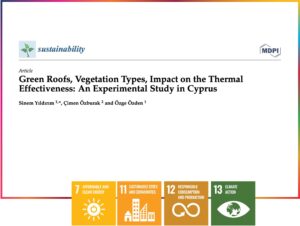
Researchers Yıldırım, Özburak and Özden from Near East University conducted a study on the impact of green roofs on indoor temperatures, aiming to address the growing concern of anthropogenic activities and climate change on urban environments. The research, conducted at the Near East University Campus in Cyprus over twelve months, compared different types of green roof vegetation against a control roof with no vegetation.
The experiment included three types of green roofs, each covering 3.5 m2 roof areas with 8 cm soil depth, along with a control green roof system without insulation, soil, or vegetation. Elitech RC-5 temperature data loggers were used to measure indoor temperatures in the huts.
Results demonstrated that green roof huts consistently maintained lower mean temperatures compared to the control hut, particularly during the hot summer months. Notably, huts with shrub plants exhibited the lowest temperatures, highlighting the efficacy of dense vegetation cover in mitigating heat.
The study’s findings corroborate existing research, emphasizing the seasonal and thermal benefits of green roofs. Particularly in Cyprus, with its arid Mediterranean climate characterized by scorching summers, green roofs play a vital role in regulating indoor temperatures and reducing energy consumption.
As green roofs gain prominence in sustainable urban planning, especially in regions prone to extreme heat, this study underscores their significance in mitigating climate impacts and promoting energy efficiency. The research sheds light on the potential of green roofs to cool interior living spaces, especially during summer, while also providing insulation during colder months.
The implications of this study extend to future urban development in Mediterranean regions and beyond. With climate change exacerbating warming trends, the integration of green roofs into building design and urban planning initiatives becomes increasingly vital. By harnessing the positive effects of green roofs on urban climate regulation and building insulation, cities can work towards more sustainable and resilient futures.
More Information:
https://www.mdpi.com/2071-1050/15/3/2807